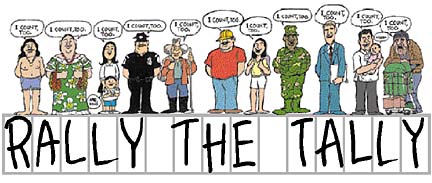Advertisement - Click to support our sponsors.


Native Hawaiian advocates
Where to get help By Tim Ruel
and others urge residents to
respond to the survey
Star-Bulletin
Census 2000 forms have to be returned this week, but so far only about 45 percent of Oahu residents have responded.
Those who don't meet the end-of-the-week deadline can expect to hear a knock at the door one night in the coming months. From April 27 to July 7, some 2,000 census takers will walk house-to-house across the state, typically after regular working hours and on weekends.
They will be asking the same questions that appeared on the census forms that weren't returned.

Karen Kanoho of Waimanalo had not completed the six-page form that appeared in her mailbox two weeks ago when she was interviewed recently."I just hope everyone isn't like me and has filled out theirs," she said. But Kanoho has an explanation for her tardiness: "I've been sick. My whole household has been sick."
Fewer people have answered the survey in recent years, according to the U.S. Census Bureau. In 1970, 78 percent of U.S. households mailed back surveys. That dropped to 75 percent in 1980 and to 65 percent in 1990. Officials expect it to slide to 61 percent this time.
Some 470,598 Hawaii residents received their census forms earlier this month. About 78,400 of those people got the long form, which asks a long list of detailed questions.
As of yesterday, about 128,800 Oahu residents had mailed back their forms. That's 45.1 percent, close to the national average, said Bob Asato, manager for the bureau's Honolulu office.
Asato hopes everyone fills out their forms soon. The 1990 census undercounted Hawaii's population by 20,500 people, costing the islands $6 million in federal funds.
Some states, including California and Hawaii, have formed their own committees to assure complete counts this time, said Lynne Choy Uyeda, spokeswoman for the Census Bureau's Western region. That's on top of the federal government's $6.8 billion budget to run and promote the census.California spent $24.7 million on the effort. Hawaii officials were not sure how much they spent.
Kanoho, who is native Hawaiian, doesn't want another undercount, especially when it comes to Hawaiians. To her, the census means proper U.S. funding for social programs, which are critical to Hawaiians. For that reason, she's pleased that Hawaiians now have their own category.
For the first time since the once-a-decade census began in 1790, Hawaiians and Pacific Islanders share their own racial category, one of 12 possible ethnic choices. Before, the government did not distinguish the Hawaiian ethnicity from Asian or Native American.
People now can also mark more than one racial category.
It's good for Hawaiians to have their own category, Asato said. He said the office hasn't received any complaints about the racial classifications.
But Frank Machado, a 62-year-old Mililani homeowner of Portuguese descent, thinks the specific classifications don't make room for the state's melting pot.
"You can't come to Hawaii and ask for nationality," said Machado, who works as an office manager for a construction company. His wife, Rochell, has six ethnic backgrounds. He calls his daughter the "poi dog."
Moreover, Machado said the census only gives him the option of being Caucasian.
That's not right, he said. "You ain't got a place for Portagees!"
He said he filled out the form right away just to get rid of it. He said he doesn't care about the census, even if it provides a head count for government funding.
"We've still got to go begging to Congress for money," he laughed.
Questions? Where to find
census helpIf you have questions about your census form, or have not received it, you may call 800-471-9424, from 3 a.m. to 4 p.m. Hawaii time.
Forms are available online at: www.2000.census.gov
A look at Hawaii's people over the decades: Population potpourri
In 1950, the state had nearly 500,000 residents, less than half its current population. About 30,000 people lived on Kauai in 1950, compared with 51,000 in 1990. The only island to see a drop during those 40 years was Lanai, which went to 2,426 people from 3,137.
The number of unmarried women in the state nearly tripled from 1960 to 1990, to 184,000.
Hawaii's population will hit 1.24 million this year, and 1.49 million by 2020, with more than a million living on Oahu alone. The largest increase is forecast for the Big Island -- 27.17 percent -- to 205,400 in 2020 from 149,600 in 2000.
The state's population is aging -- the median age jumped 15.5 percent to 33.5 years in 1990, from 28.3 years in 1980.
Source: U.S. Census Bureau and the state Department of Business, Economic Development and Tourism, and Historical Statistics of Hawaii